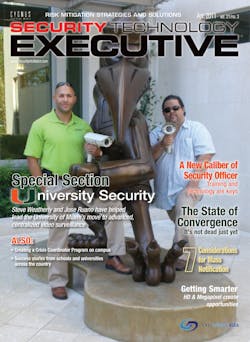Founded in 1925, The University of Miami is well-known for its academic excellence and its highly successful sports teams. Led by President Donna E. Shalala, the university is comprised of 12 schools and colleges serving more than 15,000 undergraduate and graduate students in more than 180 majors and programs.
Like all institutions of higher learning, there exists a tension between maintaining an open learning environment while at the same time taking concerted action to ensure the safety of students, staff and visitors to the university’s main campus of more than 225 acres.
At the core of the university’s security strategy is video surveillance, and the university has maintained such surveillance for a number of years. But as Jose Ruano, Executive Director of IT Security, explains, “Our challenge is that a university, by its nature, is very de-centralized — with many different independent departments. In 2006, we found ourselves with so many different legacy analog systems of various sizes, all separate from another, managed by different departments. We were looking to bring it all together into one system that we could manage in a unified way.”
University of Miami Campus Police are responsible for monitoring video and investigating incidents, but as Ruano points out, this was made difficult by the disparate and non-integrated systems with DVRs spread out all over the campus.
“You might have an incident happen in one part of campus — a bike stolen for example,” Ruano says. “To then investigate where that person came from and where the bike went could have involved trying to get video footage from five separate systems that recorded video as the incident unfolded across campus. This was very inefficient and often did not result in a successful investigation.”
Moving to Centralized IP Video
In order to integrate all the different video surveillance systems into a single unified solution, Ruano and colleague Steve Weatherly, Senior Security Engineer, knew the university needed to upgrade to IP. “It was much more economical to upgrade our cameras and run them over the existing IP network than it was to lay a lot of coax,” Weatherly says.
Weatherly and Ruano conducted extensive research into potential technologies, and they identified a number of companies they wanted to visit at the ISC West security tradeshow in 2006. “When I first saw a demo of megapixel camera technology, I was blown away at the quality compared to analog,” Weatherly recalls.
After completing their research and comparing live demonstrations, UM’s security team settled on IQinVision HD megapixel IP cameras. In addition to selecting IQeye cameras, the university chose the NetDVMS video management software from OnSSI.
Installing and Fine-Tuning
To date, there are 424 surveillance cameras on the centralized network, managed by the OnSSI system. 90 percent of the cameras are from IQinVision and range from standard resolution VGA up to 5 MP cameras, installed where forensic-quality images are essential.
Unlike many installations of this size and complexity, the university’s IT Security department does its own installation and maintenance work. They do not have an integrator, all the work is done by university staff. “Most of our staff are engineers,” Weatherly says, “so we had the initial skill sets and now we are further developing this expertise in-house.”
In fact, four IT Security technical staff have attended “IQU,” IQinVision’s training and certification program.
IT Security staff work closely on a regular basis with Campus Police to select each camera for a location and specific camera placement to achieve the field of view goals for that camera or set of cameras.
Prior to upgrading video surveillance and increasing the number of cameras installed, Campus Police conducted an analysis to identify the campus’s high-crime areas. Cameras were then installed to address pressing needs at the locations identified in the study. The police update the crime study annually so IT Security staff can continually tweak the system to meet changing needs and address where video surveillance is most needed over time.
IQeye cameras are installed wherever image quality is critical for identification purposes — parking lots and areas that typically have a high density of students. For the University of Miami’s megapixel cameras, image quality was a critical requirement. “You often see with those typical convenience store robberies that the camera gets an image, but you can’t see who the bad guy is,” Ruano says. “We’ve had several instances in which the police get a screen shot or a video clip from 20, 30, even 40 feet away and you can ID that person.”
All cameras on the centralized system are managed through the OnSSI software and fed into a central control located in the Campus Police Dispatch room. The control room displays video on 40-inch monitors and video is running and can be monitored 24/7 — although video is used mostly for post-event investigation. “The quality of pictures available to the police has definitely improved, so it is much more effective in making positive identifications,” Ruano adds.
The OnSSI video management software enables Campus Police to view images from all the IQeye and other cameras, while each school or separate department can view only the cameras installed in its buildings or area. In the police dispatch room, officers can review video from a touchscreen interface aided by mapping software that enables the viewer to drill down to the location and view what they want easily.
“The university administration sees our video surveillance system as an important, valuable deterrent tool,” Ruano says. “Some see Miami as a high-crime city, so the fact that we have a video surveillance system of this size and high quality is very important for our student’s parents — they need to be assured that the university has made, and will continue to make, a major investment in the security infrastructure in order to provide a safer environment for their children.”
Future Expansion
Even with 424 cameras currently on the centralized video surveillance system, there are still more than 100 cameras that will eventually be incorporated under the single, unified video management system. For any new construction in which video will be installed, requests must go through Campus Police. This means the IT Security Department will then consult with the police to ensure all new cameras are incorporated into the existing centralized IP system.
Weatherly, Ruano, and other university IT Security staff continue to explore ways to assist law enforcement in more effectively performing their critical work. Improvements under study include enabling police to view video from squad cars and the ability to monitor video on iPads or other mobile devices while patrolling on foot. Ruano and Weatherly are conducting due diligence on H.264 cameras as well as facial recognition and license plate recognition software to constantly improve the police’s capabilities.
“Staff and faculty notice the IQeye camera’s sleek design, which is not intimidating, yet it has a great picture and it blends very well with the environment — it’s aesthetically appealing,” Weatherly says. “They have seen these cameras and they feel protected.”
Ruano and the University of Miami have come a long way in the last five-plus years, going from a host of random DVRs scattered throughout the campus to what will soon be a 500-camera, centralized, unified megapixel quality video surveillance platform. “There has definitely been a reduction in the number of incidents,” Ruano says. “Police have been able to solve a lot more crimes than in the past and they are closing the cases faster. This technology makes them much more productive.”



